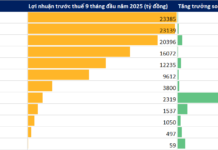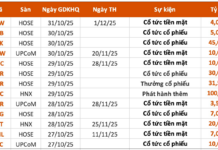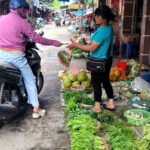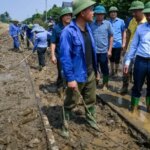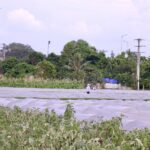According to the Ministry of Agriculture and Rural Development, Storm No. 3 and the subsequent heavy rains caused severe damage to agricultural lands and infrastructure. The storm resulted in the flooding of 200,721 hectares of rice paddies, 50,642 hectares of crops, and 61,072 hectares of fruit trees. Additionally, 3,722 fish cages and rafts were damaged or washed away, along with the loss of 26,485 cattle and 2,936,840 poultry.
THE STORM WREAKS HAVOC ON FARMS AND FINANCES
In Tuy Loc commune, Yen Bai city, dead pigs were strewn across the fields, village roads, and river banks. Tran Thi Vinh, owner of a pig farm run by Hoa Binh Minh Company in Tuy Loc, described the storm as beyond imagination. Before the storm, the farm had over 5,000 pigs weighing between 60 and 120 kilograms each, just one to two months away from being ready for market. However, the flash flood swept through, taking all but 50 pigs with it. The loss of the farm not only resulted in a staggering financial blow of 25 billion VND in investment losses but also left dozens of employees jobless.
“I’ve been in a state of shock for a week now, unsure of where to begin picking up the pieces. Everyone in the area has suffered losses, so I don’t dare ask for much. I just hope that the government can provide some support to help us get back on our feet.”
Tran Thi Vinh, owner of the pig farm in Yen Bai.
Vu Kim Viet, Chairman of the People’s Committee of Tuy Loc commune, acknowledged that it would be challenging for the Hoa Binh Minh Company to rebuild their pig farm with a herd of over 5,000 pigs. The local authorities have devised a plan to clean up and collect the dead pigs from the village roads, ditches, and fields to prevent the outbreak of diseases.
In Dong Anh district, Hanoi, the flash flood overnight claimed the lives of hundreds of thousands of egg-laying hens belonging to Hoang Ngoc Doan’s household in Bai Gia, Tam Xa commune. “Because our farm is located about 2 kilometers from the Red River, the rising water levels quickly inundated the area. We were caught off guard, and within a single night, most of our hens, which were in their egg-laying prime, were swept away, along with our dreams and investments,” said Mr. Doan.

Before the storm, Mr. Doan’s farm had 150,000 laying hens, producing an average of 70,000-75,000 eggs per day, earning over 100 million VND daily (excluding expenses). Mr. Doan estimated a loss of approximately 11 billion VND from the drowned chickens alone. Including the cost of 140 tons of spoiled feed and damaged electrical equipment, the total loss amounted to 14 billion VND. “I’ve saved up for years, and now everything is gone. I’m left penniless and in debt to the bank. My family now has to pay over 200 million VND in interest to the bank each month,” Mr. Doan shared somberly.
After the waters receded, the local authorities conducted a damage assessment and mobilized excavators and manpower to help the family dispose of the deceased chickens. All the chickens have been properly buried to prevent environmental contamination.
A “NIGHTMARE” FOR SEAFOOD FARMERS
Storm No. 3 turned into a “nightmare” for seafood farmers in Van Don district, Quang Ninh province. The once vibrant Bai Tu Long region is now a desolate expanse of white. Thousands of cages and bases for oyster and fish farming have vanished. Some cage and raft remnants were washed up on the shores of Ha Long Bay, while others were dashed against the rocky cliffs.
Ngo Nam Trung, Director of the Trung Nam Cooperative, a pioneer in marine farming in Van Don, shared his grief: “People wanted to cry but couldn’t. All the achievements of the Trung Nam Cooperative and other cooperatives like Phat Co, Kien Cuong, and Thang Loi were washed away, leaving nothing behind. My family alone suffered losses estimated at over 7 billion VND,” said Mr. Trung. He also mentioned that the members of the Trung Nam Cooperative had recently invested a substantial sum to switch from foam floats to HDPE plastic floats to stabilize their cages and rafts. They had poured all their capital and even mortgaged their homes to invest in marine farming, only to have it all washed away by the storm.
“People wanted to cry but couldn’t. All the achievements of the Trung Nam Cooperative and other cooperatives like Phat Co, Kien Cuong, and Thang Loi were washed away, leaving nothing behind. My family alone suffered losses estimated at over 7 billion VND.”
Ngo Nam Trung, Director of the Trung Nam Cooperative.
On Thang Loi Island, one of the hardest-hit households was that of Nguyen Van Thanh. Before the storm, Mr. Thanh had 20,000 cages for farming various species, 200 oyster lines, and several nets for farming chim, giò, and song fish. He was also a member of the Thang Loi Cooperative for aquaculture, operating within a 6-nautical-mile radius managed by the provincial authorities. As the storm subsided, Mr. Thanh tearfully shared, “Our cages are gone; there’s nothing left. Our family’s loss is estimated at 12 billion VND.”
According to statistics from Cai Rong town, the storm washed away 71 cages, leaving 30 oyster farmers with nothing. Nine concrete ships owned by marine farmers also sank. In Van Don district alone, the preliminary estimate is that 1,340 households farming various species, including oysters, thưng, sần, abalone, tu hài, snails, and fish, have been severely affected.
Trương Thị Thúy Huyền, Head of the Agriculture Division of Van Don district, reported that the storm caused losses of over 32,110 tons of aquatic products in the district. Oyster farmers lost more than 25,637 tons, fish farmers lost 636 tons, and other marine farmers lost over 5,480 tons. The storm has virtually wiped out the marine farming industry in Van Don, with estimated losses exceeding 2,280 billion VND.
OVER 300,000 HECTARES OF RICE AND CROPS INUNDATED
In the provinces of Thai Binh, Nam Dinh, Ha Nam, and Hanoi, vast areas of rice and crops were flooded, with many fields completely devastated by the storm. Vu Tien Tham, a farmer in Dong Xuan commune, Dong Hung district, had 40 hectares of rice in the critical stage of panicle emergence to flowering, which was submerged by the storm. By September 15, 2024, the water levels in the fields had decreased significantly, but in the Cửa Chùa lowland area, the water still exceeded the panicle height. Approximately 30% of the rice fields are considered a total loss. “I haven’t witnessed such a severe storm and flood in many years. The natural disaster struck at a sensitive stage for the rice, and the extent of the damage is beyond what I imagined,” said Mr. Tham.
For seven days, Vu Van Giang’s 8-hectare field in the Cửa Chùa lowland area was submerged, and his rice crop was turning yellow with signs of rot. Clinging to hope, Mr. Giang bought pesticides to prevent insect and disease damage as advised by agricultural experts. “This year has been challenging for farmers. The more we plant and cultivate, the more we lose. At the beginning of the season, heavy rains forced me to replant this field three times, and now, just as the rice was about to flower, the floods hit. I’m doing my best to care for the crop, applying pesticides to prevent and control pests and diseases, hoping to salvage whatever I can,” shared Mr. Giang.
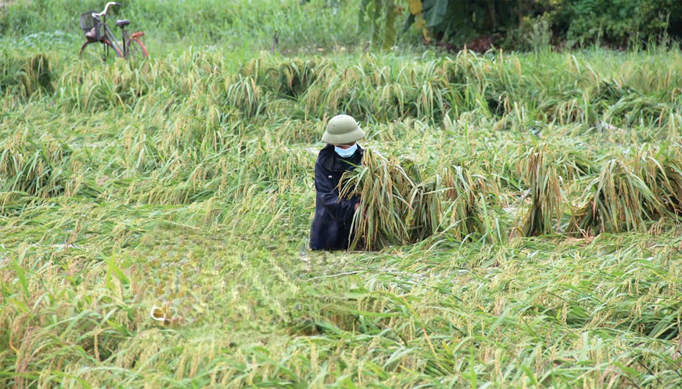
From September 6 to 14, 2024, rainfall in Tien Hai district reached nearly 600mm in some areas. The heavy rains, combined with rising floodwaters, made water drainage challenging in the downstream district, resulting in the inundation of thousands of hectares of rice fields, with approximately 1,000 hectares suffering a 70% loss. In Quynh Phu district, the storm also significantly impacted agricultural production.
“It is estimated that in Quynh Phu district, Thai Binh province, about 4,500 hectares of summer-autumn rice have suffered a yield loss of 20-30%, and 500 hectares have suffered a loss of over 50%. Summer-autumn crops on an area of 1,500 hectares were also affected. The district has issued directives and provided guidance to help people cope with the aftermath and is conducting a detailed survey of the damaged areas to propose support in accordance with current regulations to assist people in resuming production.”
Do Tien Cong, Head of the Agriculture and Rural Development Division of Quynh Phu district, Thai Binh province.
According to a report by the Office of the Steering Committee for Natural Disaster Prevention, Search and Rescue of Thai Binh province, the storm affected approximately 11,000 hectares of summer-autumn rice in the province. However, due to effective drainage measures, the area with over 30% damage has been reduced to about 6,000 hectares. Additionally, 585 hectares of unharvested and newly planted vegetables were affected by 30-70% damage, and 2,760 hectares were affected by over 70% damage. About 1,215 hectares of fruit trees were affected by 30-70% damage, and 170 hectares were affected by over 70% damage.
Furthermore, some livestock enclosures were damaged, with roofs blown off, walls collapsed, and biogas digesters ruptured. Several fish cages on the Red River in Hung Ha district were overturned and washed away, resulting in the loss of approximately 60 tons of fish, including species such as lang, carp, diêu hồng, and tram. The total loss to the agricultural sector in Thai Binh province is estimated at 350 billion VND.
According to a report by the People’s Committee of Nam Dinh province, the total damage caused by Storm No. 3 and the accompanying floods is estimated at nearly 564 billion VND. The most affected sector is agriculture, with 18,102 hectares of rice affected, resulting in a loss of 381.5 billion VND. Additionally, 3,800 hectares of vegetable crops were damaged, with losses estimated at 105.75 billion VND, and 2,145 ornamental plants of various types were affected, with losses of 1 billion 136.5 million VND…
RALLYING TOWARDS RECOVERY
On September 15, 2024, Prime Minister Pham Minh Chinh chaired a conference with the affected localities to discuss recovery efforts. He instructed the localities to assess the damage to production and business facilities to restore cultivation, animal husbandry, and services. He emphasized the importance of credit policies, support for seeds and seedlings, fertilizers for agriculture, and assistance for service industries to prevent disruptions in supply and production chains.
The Prime Minister directed the State Bank and the banking system to consider policies for debt rescheduling, forbearance, and restructuring, as well as soft loans and zero-interest loans. He also instructed the Ministry of Finance to look into tax reductions, extensions, and exemptions and the Ministry of Industry and Trade to ensure the supply of materials and inputs for production and business operations. The Vietnam Bank for Social Policies was tasked with providing loans to households, and the insurance sector was instructed to promptly settle claims for businesses and individuals affected by the storm…
The Prime Minister requested that ministries, sectors, and localities proactively implement the six major tasks and solutions based on their functions, tasks, and authority. He also called upon the spirit of “national unity, mutual support,” “love thy neighbor,” and “sharing burdens and joys.” He emphasized the importance of unity and collaboration to overcome the aftermath of Storm No. 3, stabilize people’s lives, restore production and business activities, control inflation, and promote economic growth to achieve set targets…
This article was published in the Vietnam Economic Times, Issue 39-2024, released on September 23, 2024. To read the original article, please visit: https://postenp.phaha.vn/chi-tiet-toa-soan/tap-chi-kinh-te-viet-nam
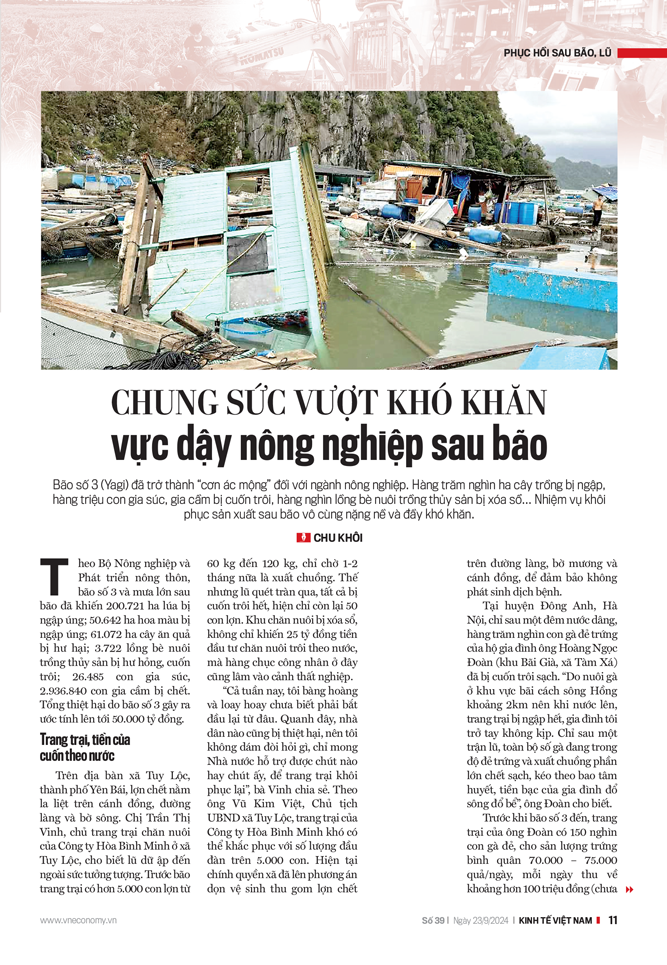
Hòa Phát Donates 30 Billion VND to Aid Relief Efforts in the Wake of Storm No. 3
As one of Vietnam’s leading corporations, Hoa Phat Group is committed to supporting the community during these challenging times. We plan to provide assistance through various channels, including donations via the Vietnam Fatherland Front, direct cash transfers to families in need, and reconstruction and repair of schools in the most affected provinces. With these efforts, we aim to make a meaningful difference in the lives of those impacted by recent events.
The Green Grocer’s Conundrum: Northern Markets Still Facing Scarcity of Fresh Vegetables
The recent surge in green vegetable prices, now double or triple what they were pre-storm, underscores the urgent need to restore production areas swiftly.
The Capital’s Green Grocer: A Tale of Resilience and Recovery
After days of relentless rain, the vegetable fields of Me Linh district, Hanoi, lay bare and battered despite their nylon covering. Yields have taken a significant hit, and farmers are rushing to salvage what they can through early harvesting.










